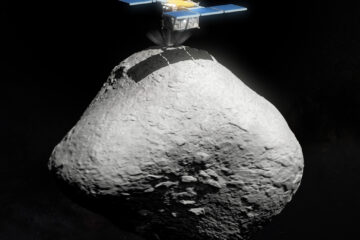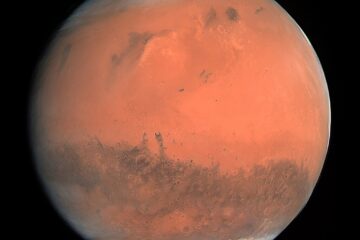A feast without famine
A white dwarf “eats” a Pluto-like planet

Even though it’s been in Earth orbit for over 35 years, the Hubble Space Telescope (HST) is still providing astronomers with useful information about the universe. And it continues to play a part in working with both major observatories on the ground as well as other large telescopes in space. Combining between them what portions of the electromagnetic spectrum they can observe best can really paint a better picture of our understanding, especially when it comes to unusual events. In this case, however, Hubble gets all the credit.
In previous news items we have talked about the birth of the solar system 4½ billion years ago, but left out an interesting feature not covered before. Related to one kind of debris left over from the cloud of dust and gas, a nebula, from which it formed, it’s called the Kuiper belt (pronounced “KOI” like the Japanese ornamental fish and “purr” like the sound a cat makes).

Like many things in astronomy, this feature is named after a person, Gerard P. Kuiper (1905 – 1973), who first proposed its existence. This Dutch-American astronomer, planetary scientist, selenologist (a person who studies the Moon), author, and professor, did so in 1951, but it was not confirmed until the discovery of actual bodies occupying this part of the solar system beginning in the late 20th century.
Similar to the major asteroid belt lying between Mars and Jupiter, the Kuiper belt is a disk-like belt of smaller, primarily frozen gas bodies, like comets, but it’s also the home of most of the known objects astronomers now call dwarf planets: Pluto, Orcus, Haumea, Quaoar, and Makemake. Two moons, Neptune’s Triton and Saturn’s Phoebe, may have originated there, captured by their parent planets.
Instead of being at the border between the Sun’s rocky and gas giant planets as the asteroids are, the Kuiper belt lies beyond the orbit of Neptune, covering from between about 30- to 50-times Earth’s distance from our star. This Earth-to-Sun unit of distance defines the astronomical unit, which is abbreviated “au,” with 1 au being our average distance from the Sun. The Kuiper belt is also 20-times as wide and some 20-to 200-times more massive than the better-known asteroid belt.
It turns out that such rings of icy debris have also formed around other stars astronomers know have planetary systems, exoplanets, of their own. Which is where HST comes into this article.

One of the parts of the electromagnetic spectrum HST can observe in is ultraviolet, which has allowed it to study an extra-solar system object, what appears to be a body like Pluto, which is being “eaten up” by a compact white dwarf star at the center of its system. In this artist’s view we can see the bright white dwarf at the center of a group of exoplanets, and the frozen source of the “meal” to the right.
Relatively “close” at some 260 lightyears away, this former sun-like star is about half the mass of our own Sun, but physically the size of Earth. Researchers think that its massive gravity pulled apart this otherworldly “Pluto.” Study of its debris by using an instrument onboard Hubble have shown that it was originally about two-thirds ice plus it contained a very large amount of nitrogen.
It’s HST’s unique abilities which make such a study possible. This combination of materials making this “Pluto” up is what makes the destroyed object similar to our well-known dwarf planet, which also has a similar ice composition. Not only that, but our Pluto’s surface is known to be paved with nitrogen ices. This also points to its existing in a distant system of planets having its own analogy to the Kuiper belt, but surrounding another star.
White dwarfs are always interesting as astronomers know our own Sun is going to evolve into one of these once it uses up all of its nuclear fuel in some 4½ billion years. Whether or not its future gravity after collapsing into such a white dwarf will be powerful enough to break up the dwarf planets in the outer solar remains to be seen. We can speculate all we want today, but the chances are infinitesimally small we’ll actually be around to find out.
For more general information, follow this link.
By: Tom Callen



